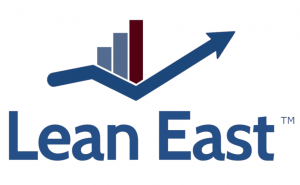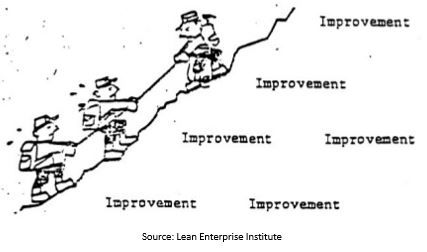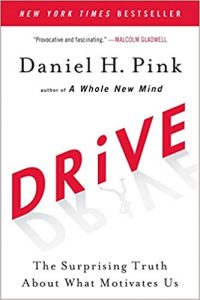
This past month has been a busy one for Lean East with several new clients. As I reflect on lessons from the past month to blog about, one theme has come up several times in my discussions with top executives. The discussion goes something like this:
Executive: “I don’t think this employee is going to work out.”
Me: “What is the issue?”
Executive: “I’m hearing complaints from the team about this employee. He/she isn’t keeping up with the work. When I look into their projects they are often falling behind.”
Me: “What is the employee’s expectation and how is it measured?”
Executive: “They know they have to keep up and be responsive. When I sent the employee an email to ask about a recent issue they didn’t even email me back.”
Me: “Can we review the employee expectations?”
Executive: “We don’t have that written down. Employees just know.”
Think Win-Win
During these recent executive discussions, I wanted to share Stephen Covey’s “Green and Clean” Servant Leadership story with them. But, I had not reviewed it myself in years. The story is related to Habit 4: Think Win-Win from Stephen R. Covey’s bestseller The 7 Habits of Highly Effective People. Thinking Win-Win is the first habit of interdependence, or working with others, and having a frame of mind and heart that constantly seeks mutual benefit in interactions. A “win” for all is a better long-term solution than having one side in a negotiation “lose.”
Win-Win isn’t about being nice or giving in. It requires more effort to understand what constitutes a “win” for each side and then structure an agreement to maximize benefits for all.
Green and Clean
In my research on the story, I found that “Green and Clean” isn’t from The 7 Habits of Highly Successful People but rather from the highly recommended Stephen Covey book, The 7 Habits of Highly Successful Families published in 1997. Similarly, I found a great 5-minute video that tells the story. Watch the video below before I relate it to my executive’s complaint.
Servant Leadership
“Green and Clean” is a wonderful example of Servant Leadership. The story is about a father and son, however, the same story could easily be told about a leader and his or her employee.

Here are three keys to Servant Leadership:
- Stewardship: Servant Leadership requires the leader to set clear expectations of the desired results and obtain the employee’s ownership of the goals. The leader is available as a resource (in service to the employee, as requested by the employee) but does not own the project. The employee owns the project.
- Not micro-management: Once the employee agrees upon the targeted results and guidelines for achieving them, the manager needs to follow the agreement. Specifically, they need to focus on not managing the methods used to obtain the results. You saw how hard this was to do for the father in the story. Raising a boy (or developing an employee’s management skills) requires letting go and allowing mistakes. This is where learning and development occur.
- Intrinsic Motivation: This is the act of doing something for a personal sense of accomplishment without any obvious external rewards.
 Daniel Pink Example
Daniel Pink Example
Daniel Pink shares an excellent example of intrinsic motivation in his book Drive: The Surprising Truth About What Motivates Us. Pink imagines asking an economist to predict which product would be more successful:
-
-
- An encyclopedia to be shared by subscription and CD-ROM begins as a major initiative by Microsoft soon after their Windows 95 product launch. The team will be full of highly paid researchers and programmers.
- An online encyclopedia created online and offered for free. All of the content will be submitted by volunteers, and nobody who submits an article will be compensated.
-
Every economist would have predicted Microsoft would have a more successful product, but MSN Encarta was discontinued in 2010. Wikipedia has gone on to dominate the market and become one of the most visited websites in the world. All were created by people who were intrinsically motivated and did not make any money for their work.
Servant Leaders must focus on employees who are intrinsically motivated to perform and exceed expectations. Let the external rewards (like a raise, bonus, or career advancement) follow success, not drive the project.
First, deal with the three keys of Servant Leadership described above. Then, ensure you set up a Win-Win Agreement with the employee you are developing.
Win-Win Agreements
There are five elements of a Win-Win agreement both sides must understand:
- Desired results – what success looks like. In the story, it is “green” and “clean” as compared to the neighbor’s yard. For my executive, however, it could be how many projects to complete and getting them completed on time.
- Guidelines – these are the constraints that further define the desired result. In the video, the Dad has the son accept accountability. He says watering is going to be needed, but he leaves the method up to the son. Lean East helps executives set guidelines based on a balanced scorecard of indicators to ensure that quality, service, and continuous improvement are not ignored when meeting the desired results.
- Resources – in the video, the Dad is the main resource. For the executive, resources can be monetary (with budgetary guidelines), support from the leader or other staff, executive coaching or consulting, etc.
- Accountability – the Dad in the video sets clear accountability where the son will be the boss and judge himself. He also sets a clear time frame for when they will review the progress together. Executives must do the same – obtain agreement on ownership and then regularly review the metrics in check-in meetings.
- Consequences – the Dad didn’t explain the consequences in the video, but they were intrinsic (satisfaction for a job well done) and allowance-based. Executives can offer praise, advancement, and momentary rewards for success and negative consequences can include less responsibility and less pay.
Written agreements are always recommended to avoid misunderstandings. Contact us for examples of performance planning documents we have used successfully.
Lean Principles
The Lean East team hopes you find the “Green and Clean” Servant Leadership story helpful whether you are a leader or a Lean Practitioner. The “Green and Clean” story agrees with Lean principles in many areas:
- “Raise boys, not grass.” Effectiveness is more important than efficiency.
- Respect people and do not micro-manage their methods
- Standard work and Daily work
- Toyota Principles, especially their desire to “Grow Leaders”
- Encourage continual improvement of the methods and experimentation to find better ways to achieve the goal
- Set a good example by acting like a leader yourself
Please let us know what other principles you observed in the “Green and Clean” story in the comments below.

 Daniel Pink Example
Daniel Pink Example
Related Posts
The God Complex: Why We’re All Making This One Mistake
How I am Changing the Career Advice I Give My Kids
This is Never Going to Work: Getting Lean Projects Unstuck